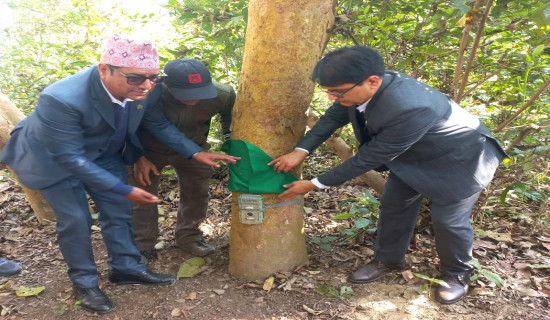- Tuesday, 16 December 2025
Tiger Population Doubles
BNP's Conservation Efforts Pay Off
The world is celebrating Global Tiger Day on July 29 (today). Nepal is also celebrating the day with various programmes. The release of the results of the National Tiger Census, conducted in December last year, will be the main attraction of this celebration. Today is the day to feel proud that Nepal achieved successfully the target of doubling its tiger population by fulfilling its commitment made in the Russia Forum in 2010. Nepal is one of 13 tiger range countries that made the commitment to the conservation of tigers and increasing their population.
The appreciable growth in the tiger's number is an indicator of the well-being of the ecosystem. The top carnivore or apex predator of the terrestrial ecosystem is known as the umbrella species.
In Nepal, the tiger population exists in fragmented locations in the Terai region and the core sub-population is concentrated in the protected areas of Bardia National Park, Chitwan National Park, Parsa National Park, Banke National Park and Shukla Phanta National and the districts of Banke, Bara, Bardia, Chitwan, Dang, Kailali, Kanchanpur, Makawanpur, Nawalparasi, Parsa and Rupandehi.
For a decade, the country has been working to double the tiger population as a part of its commitment made in the Russia forum. Expansion of habitats like establishing Banke National Park mainly for tigers and grassland management, increasing prey species and water resource management remain major efforts for doubling the tiger population.
We have started witnessing the success of conservation efforts. Bardiya National Park (BNP) has also won this year’s TX2 Award (Conservation Excellence Award) for doubling the population of wild tigers since 2010. Tiger Conservation Excellence will be presented to Khata Forest Conservation Area in Nepal, which secures transboundary connectivity for tigers between Nepal and India. The awards will be given on June 29 (today) at a Tiger Day Celebration event in Kathmandu. The park is the largest national park in the Terai lowland and covers an area of 968 square kilometres.
The International Union for the Conservation of Nature (IUCN) categorised tigers as “Endangered” list on the Red List of Threatened Species and conserving them has become a global priority. Recent data from the IUCN also said that the number of endangered tigers around the world is 40 per cent higher than previously thought. With the increase in its population, it has also brought new challenges such as dealing with habitat loss, and human-animal conflict.
Challenges
An increase in the tiger population has posed a challenge- tiger-human conflict. Kaushi Devi Pal, a local of Kothiyagau in Madhuban Municipality-2 of the Bardiya district is the latest victim of wild animal attacks in Bardiya. Pal, 45, was killed in a Royal Bengal tiger attack when she was grazing her goats in a community forest adjoining Bardiya National park on May 24, 2022. Similarly, Asmita Tharu, 41, of Sonaha in Madhuban-2 of the district was injured when a tiger attacked her while collecting firewood on June 6, 2022.
The conflict is said to be for the territory. Mainly, the people from Tharu, Sonaha and Chepang communities have been staying nearby the national parks and community forests for decades and it will be hard for them to leave the settlement. On the other hand, wild animals like tigers are also fighting for their territory and they do not want any disturbance in their habitats.
Human-wildlife conflict has continued unabated in Banke and Bardiya districts, resulting in 29 human casualties and several incidents of injuries in the past five years. Among them were 23 casualties from Bardiya National Park, a buffer zone, and community forests.
People are asked not to go to the forest without permission but still many locals enter the national park and forest areas and take their livestock for grazing. Sometimes they are attacked by tigers while picking wild plants, collecting animal fodder and firewood in the forest, buffer zones and national park areas, said chief conservation officer of the BNP Bishnu Prasad Shrestha. "None of the incidents happened in their houses or their farmland. Humans are not a tiger's priority, but when they feel insecure, they attack people," he said.
The East-West Highway passes through or adjacent to the BNP has resulted in road-killings of wildlife. Human encroachment into forest areas and the construction of physical infrastructures have also continued at a rapid pace.
Excessive quarrying of stone, gravel, and sand in the Karnali River towards Kailali and construction of unorganised settlements and population growth are other challenges to wildlife habitats. These are also the reasons for tigers to become aggressive towards humans.
With the increase in population, wood, logs, stone, gravel, sand and other materials are in high demand. People living nearby the protected areas are also dependent on forest materials to fulfil their daily needs. Dahan Lal Chaudhary, 54, of Madhuban Municipality, said they are fully dependent on the forest. "We have been staying in this area for decades since our ancestor's time but in the last few years we are living with the fear of tigers and losing our people to conflict."
He said, "We support conservation, but we want security from such wild animals." They also demanded the translocation of tigers from the Khata community forest, an adjoining forest of the national park and barbed wire fencing to protect them from possible attacks of wild animals. Locals living near buffer zones have been demanding infrastructures that are friendly to both humans and wildlife.
Loss of Habitat
According to conservationists, wild animals feel intimidated by their surroundings when they see people’s movements. The encroachment near the park area is slimming down the habitat of wild animals such as tigers and rhinos, said Shanta Raj Gyawali, a senior advisor at the World Wide Fund for Nature (WWF).
Climate change and global warming pose threats to tigers and force them along with other species to shift their belts and migrate towards colder regions. The construction of infrastructures like roads and canals in the park and forest areas has created more problems for animals as they often encounter humans in such places. Human settlements near forests and protected parks have given rise to threats to people.
Some of the experts pointed out that the casualties and destruction of properties have taken place just because of the lack of sufficient habitat and prey species to the wild animals. The animals come out of the reserved areas in search of food. The hungry animals are often angry and are ready to attack whoever comes near them. The authority should therefore focus on habitat expansion and increase the number of prey species to minimise such incidents.
But, in the case of BNP, Shrestha said there were enough prey species inside the park. There are 95 individual prey species in one square kilometre for tigers. Following the rise in wildlife attacks on humans, authorities are working on various measures including the relocation of conflict-making tigers. The government recently captured six tigers from Bardiya and one from Banke. They were later translocated to the Central Zoo, Chitwan National Park, and one was put inside a cage in BNP.
Recently, the government decided to set up the Prime Minister Human Wildlife Rescue and Relief Fund to conserve tigers and reduce human-wildlife conflicts in buffer zones of national parks and forest areas with the commitment to double the tiger population. Other various measures have also been taken to decrease conflict between humans and wildlife and maintain their co-existence. National parks have for the first time launched a five-year strategic plan in this regard, said Shrestha.
This tiger conservation action plan (2016-2020) also focuses on the improvement and restoration of tiger habitat through effective management of waterholes, grassland, corridors and connectivity. It aims to control poaching and illegal trade and resolve tiger-human conflicts through effective law enforcement and engagement of local communities.
To control human-tiger conflict and illegal activities on the highway (east-west highway) that passes through the BNP, altogether 38 police check posts have been established at various locations. Since January last year, pedestrians and two-wheel vehicles have not been allowed to use the highway in the Amreni-Chisapani section of the park alone. Speed is limited to 40KM per hour in the Amreni-Chisapani section of the east-west highway. Hoarding boards are placed at various places on the highway, highlighting signs of a wildlife-crossing zone. Vehicles are asked to lower their speed. To prevent tiger attacks, park authorities have placed several restrictions on residents residing near buffer zones.
Altogether 76 per cent of the area of the park is covered with forest, 1.47 grassland and 1.63 per cent with water bodies. Around 200 ponds including artificial are conserved inside the park for wild animals. Many of the ponds are artificial, where water is filled with pumps using solar power. The pumps operate automatically on sunny days.
Compensation
Bio fences, electric fences, gabion fences, RCT fences and various other measures are used to prevent wild animals from entering human settlements. The government has also been distributing compensation to the wildlife victims. According to wildlife damage relief guidelines-2069 ( the third amendment 2075), the monetary compensation amount for human casualties is up to Rs. 200,000 per person and a maximum of Rs. 20,000 for a person sustaining a minor injury. In case of the death of victims, they shall provide the family of a victim with 1,000,000.
The guidelines have included schemes for the monetary payoff for the loss of domestic animals and property, and the authority has arranged scholarship programmes for the children of victims.
The BNP is home to tigers, one-horned rhinoceros, leopards, donkeys, goats, swamp deer, spotted deer, and wild elephants that are among the 61 species of wild mammals, 10 of which are protected mammals. The BNP also shelters more than 513 (6 protected) species of birds, more than 42 (3 protected) species of reptiles and more than 121 species of fish.
According to the 2018 census, there are 235 breeding tigers in Nepal and the country is set to become the first of 13 countries to double its tiger population by 2022.
In Nepal, the tiger population was 125 in 2010. The conservation efforts saw it jumped to 235 in 2018. According to some estimate, the tiger number in the country should reach around 250 in the current year. The exact data on the tiger population will be made public today.
The number of tiger in the BNP was less than 20 in 2009, which multiplied more than three fold to 87 in 2018. On Friday, the exact number of tiger in this national park will be made public.
(A journalist at TRN, Indira writes on wildlife and the environment)
















